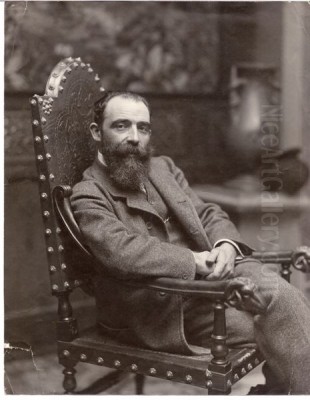
Eliseo Meifrén y Roig stands as a significant figure in Spanish art history, particularly celebrated for his contributions to Impressionism. Born in Barcelona, his life and career were marked by extensive travel, a deep connection to the landscapes and seascapes of his native Catalonia, and a masterful ability to capture the fleeting effects of light and atmosphere. His work bridged the gap between traditional Spanish painting and the burgeoning modern art movements emerging in Europe, particularly France, leaving behind a legacy of luminous and evocative canvases.
Early Life and Artistic Formation in Barcelona
Eliseo Meifrén y Roig was born in Barcelona in 1857 (some sources cite 1859). His artistic journey began in his vibrant home city at the prestigious Escola de la Llotja, the same institution that would later nurture talents like Pablo Picasso. At Llotja, Meifrén studied under influential figures of the Catalan art scene, most notably Antoni Caba and Ramon Martí Alsina (also cited as Ramon Martín Alcina).
Antoni Caba, known for his portraiture and historical paintings, provided Meifrén with a solid academic foundation. Ramon Martí Alsina, a key proponent of Realism in Catalonia and an early adopter of plein air (outdoor) painting techniques in the region, likely instilled in the young Meifrén an appreciation for direct observation and the realistic depiction of landscapes. This early training grounded him in technical skill while exposing him to the evolving artistic ideas circulating in Barcelona during the latter half of the 19th century, a period of cultural resurgence known as the Renaixença.
Parisian Training and the Embrace of Impressionism
Like many aspiring artists of his generation seeking exposure to the latest artistic innovations, Meifrén traveled to Paris to complete his training. The French capital was the undisputed center of the art world, pulsating with the revolutionary energy of Impressionism. In Paris, Meifrén immersed himself in this dynamic environment. He formed close associations with fellow Catalan artists who were also absorbing the Parisian atmosphere, including Ramon Casas and Santiago Rusiñol.
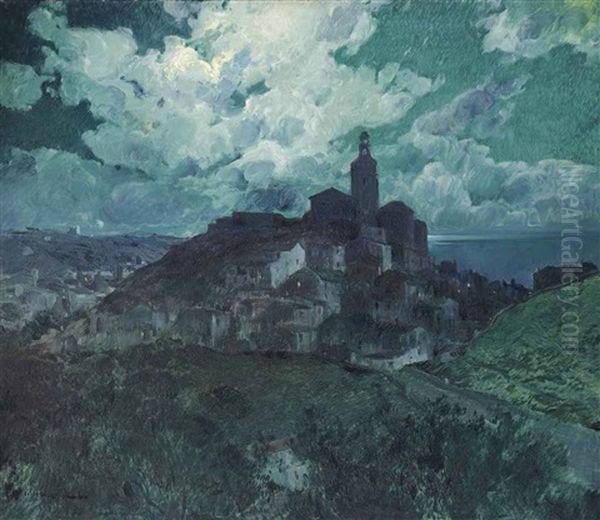
Casas and Rusiñol were pivotal figures in Catalan Modernisme, a movement encompassing art, architecture, and literature. Their experiences in Paris, particularly their engagement with Impressionist and Post-Impressionist ideas, significantly shaped their own work and, through their interactions, likely influenced Meifrén as well. The emphasis on capturing transient moments, the effects of light and color, and the use of looser, more visible brushwork were hallmarks of French Impressionism that deeply resonated with Meifrén.
He was particularly drawn to the works of core French Impressionists like Camille Pissarro, Edgar Degas, and Pierre-Auguste Renoir. Their dedication to painting modern life, their innovative compositions, and especially their scientific and intuitive approaches to color and light encouraged Meifrén to move away from purely academic or Realist constraints. He increasingly adopted the practice of painting outdoors (en plein air), allowing him to directly capture the nuances of natural light on the landscape, a practice central to the Impressionist ethos.
Artistic Style: Capturing Light and Atmosphere
Eliseo Meifrén y Roig is primarily recognized as an Impressionist painter, although his work sometimes shows influences from Symbolism, particularly in his nocturnal scenes. His style is characterized by a soft, gentle approach, often described as having an intimate tone. He employed loose, fluid brushstrokes, allowing the texture of the paint and the energy of its application to be part of the final effect. This technique contrasted sharply with the smooth, highly finished surfaces favored by academic painters.
Central to Meifrén's art was his fascination with light. He excelled at depicting the varied effects of sunlight on water, the subtle shifts in color during different times of day, and the atmospheric conditions of the landscapes he painted. His seascapes, in particular, demonstrate his skill in rendering the reflective qualities of the sea, the movement of waves, and the vastness of the maritime horizon. His palette often favored luminous blues, greens, and ochres, applied in a way that created vibrancy and captured the specific ambiance of a place.
While clearly influenced by French Impressionism, Meifrén developed a personal style rooted in his Spanish context. His work often retains a stronger sense of structure and drawing than seen in some French Impressionist works, perhaps reflecting his academic training under Caba. However, his primary focus remained the sensory experience of the landscape – the warmth of the sun, the coolness of the sea breeze, the play of light and shadow.
Themes and Subjects: Catalonia and Beyond
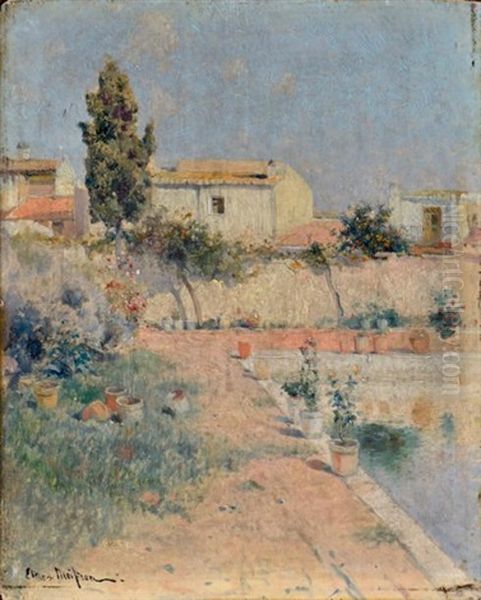
Meifrén's most celebrated subjects are the landscapes and, especially, the seascapes of his native Catalonia. He held a deep affection for the region's coastal areas and depicted them repeatedly throughout his career. The small fishing town of Cadaqués, on the Costa Brava, became a particularly favored motif. He was captivated by its rugged, rocky coastline, its picturesque white-washed buildings clustered around the bay, and the unique quality of its Mediterranean light. His paintings of Cadaqués are considered among his finest achievements, capturing the town's distinctive character and atmosphere.
Beyond Cadaqués, Meifrén painted various locations along the Catalan coast and inland landscapes. Gardens also feature prominently in his oeuvre, offering opportunities to explore the interplay of natural forms, color, and light in a more contained setting. His travels provided further inspiration; views of the Marne River in France and urban scenes from Paris demonstrate his ability to apply his Impressionist sensibility to different environments. Works like Plaza de París (Paris Square) show his engagement with urban landscapes, capturing the life and light of the city.
His dedication to landscape and seascape painting places him alongside other Spanish artists who excelled in this genre, such as Joaquín Sorolla, although Sorolla's style, often termed Luminism, had its own distinct characteristics, focusing intensely on the brilliant Valencian sunlight. Meifrén's approach, while also concerned with light, often possessed a gentler, more atmospheric quality.
Representative Works
Several paintings stand out as representative of Eliseo Meifrén y Roig's artistic output and style:
Noche en Cadaqués (Night in Cadaqués): This is one of his most famous works. It depicts the village at night, with lights twinkling against the deep blues and greens of the sky and sea. The swirling brushwork and evocative atmosphere have led some to see it as a work nodding towards Symbolism or even as an homage to Vincent van Gogh's Starry Night, though Meifrén's interpretation remains distinctly his own, capturing the specific magic of the Catalan coast after dark.
Gente de Mar (Sea People) (1933): This title likely refers to paintings depicting the lives of fishermen and coastal communities. These works showcase his interest in the human element within the maritime landscape, rendered with his characteristic loose brushwork and sensitivity to light.
El Marne (The Marne River) (1933): Painted during his time in France, this work demonstrates his application of Impressionist techniques to a non-Spanish landscape, focusing on the tranquil beauty and reflective qualities of the river.
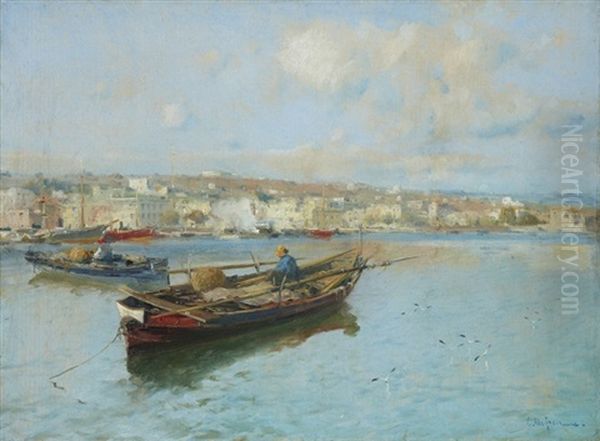
Jardín (Garden) or Paisaje de interior (Courtyard Garden): Meifrén painted numerous garden scenes, exploring the lushness of vegetation and the dappled effects of sunlight filtering through leaves. These works often have a serene and intimate quality.
Barcos de Pesca (Fishing Boats) (similar to Bateaux de pêche): A recurring theme, these paintings capture the essential character of coastal life, focusing on the forms of the boats and their reflections in the water, often bathed in the warm light of morning or late afternoon.
Marina con boya (Seascape with Buoy): Housed in the Prado collection (though possibly deposited elsewhere), this work exemplifies his mastery of the seascape genre, focusing on the expanse of water and sky, punctuated by a simple navigational marker.
La única naranja (The Only Orange): Held by the Museo de Bellas Artes de Málaga, the title suggests a still life element within a landscape or perhaps a genre scene, showcasing his versatility.
These works, among many others, illustrate Meifrén's consistent dedication to capturing the visual sensations of the world around him, particularly the interplay of light, water, and land.
Extensive Travels and International Exposure
Meifrén was a man of considerable energy and an adventurous spirit, reflected in his extensive travels throughout his career. Beyond his formative time in Paris, he journeyed widely across Europe and even ventured to the Americas. His travels took him to Italy, Belgium, Argentina, and the United States. These trips were not mere holidays; they were opportunities for artistic exchange, finding new subjects, and exhibiting his work to international audiences.
His time spent abroad significantly broadened his horizons and reputation. In 1903, he held his first exhibition in Buenos Aires, Argentina, indicating an early effort to cultivate a market beyond Spain. This proved successful, especially after experiencing a commercial setback with an enterprise at the Reial Cercle Artístic (Royal Artistic Circle) in Barcelona. His resilience led him to find appreciation and patronage in South America.
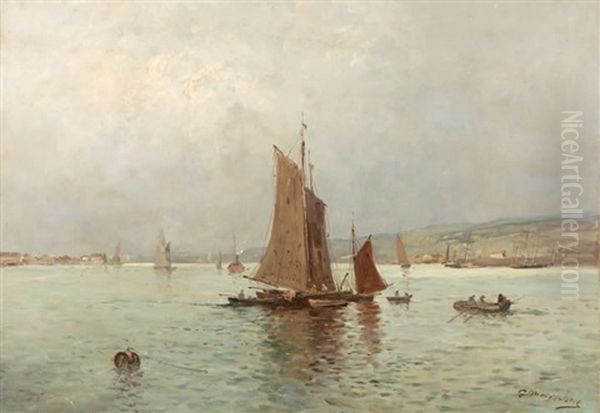
Later, in 1915, his work was exhibited at an independent gallery in New York City, where it received positive public recognition. This exposure in the United States further cemented his status as an artist of international standing. His participation in various international fairs and exhibitions also garnered him awards and accolades, confirming the appeal of his Impressionist style across different cultures. These travels underscore his role not just as a painter, but as a cultural ambassador connecting Spanish art with global trends.
Career Milestones and Connections
Meifrén's career was marked by significant exhibitions and professional engagements. His first major solo show at the prestigious Sala Parés in Barcelona in 1890, featuring seventy oil paintings, was a critical and commercial success, firmly establishing his reputation within the Catalan art scene. The Sala Parés was a vital hub for Modernista artists, and exhibiting there placed Meifrén at the center of contemporary artistic life in Barcelona.
His connections within the art world were extensive. His early association with Casas and Rusiñol in Paris remained important. He was part of a generation of Spanish artists grappling with modernity. While distinct in style, he was a contemporary of figures like Joaquín Sorolla, the Valencian master of light; Darío de Regoyos, whose work sometimes bordered on Pointillism and Symbolism alongside Impressionism; Ignacio Zuloaga, known for his more somber, traditional Spanish themes; and Isidre Nonell, another key figure of Catalan Modernisme focused on marginalized figures.
Meifrén also had contact with major international figures. Evidence suggests interactions with artists like Degas and Henri Matisse during his time in Paris. In 1903, he was involved in organizing a joint exhibition of Catalan painters that notably included five pastels by a young Pablo Picasso. While Picasso would soon forge a radically different path with Cubism, this early connection highlights Meifrén's active role in the artistic milieu that saw the emergence of one of the 20th century's most revolutionary artists.
His influence extended to teaching and arts administration. For a time, he served as the director of a provisional art school in Las Palmas (Canary Islands), demonstrating a commitment to fostering artistic talent. His final major exhibition reportedly took place in Barcelona in 1939, shortly before his death in 1940, capping a long and productive career. The mention of Francisco Goya in relation to Meifrén is primarily contextual; Goya, a towering figure of Romanticism and a precursor to modern art, influenced many later artists, including French Impressionists like Manet, but he was not an Impressionist himself and belonged to an earlier era.
Legacy and Collections
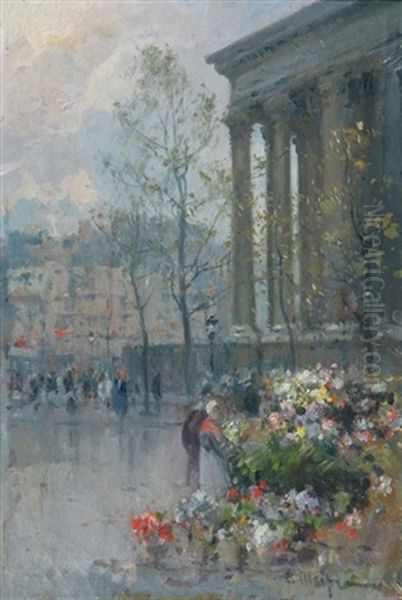
Eliseo Meifrén y Roig died in Barcelona in 1940, leaving behind a substantial body of work and a secure place in the history of Spanish art. He is regarded as one of the foremost Spanish exponents of Impressionism, particularly skilled in landscape and marine painting. His ability to absorb the lessons of French Impressionism while retaining a distinctly Spanish sensibility, rooted in the light and landscapes of Catalonia, defines his unique contribution. He successfully captured the transition in Spanish art from 19th-century Realism towards 20th-century modernity.
His works are held in several major public collections, ensuring his legacy endures. The Museu Nacional d'Art de Catalunya (MNAC) in Barcelona, the premier institution for Catalan art, holds examples of his work. The Museo Nacional del Prado in Madrid also includes his paintings in its collection, such as Marina con boya and Plaza de París, although Prado works are sometimes deposited in regional museums, which might explain mentions of collections in Palma, Mallorca. The Museo de Bellas Artes de Málaga is another key institution housing his art, including La única naranja. His paintings continue to be sought after by private collectors and appear regularly at auction houses.
Conclusion
Eliseo Meifrén y Roig was more than just a painter; he was a vital conduit through which the revolutionary ideas of Impressionism flowed into Spain, adapted and personalized through the lens of his Catalan heritage. His life was one of dedication to his craft, marked by learning, travel, and a profound connection to the natural world, especially the sea. Through his luminous canvases, filled with light, air, and color, he captured the fleeting beauty of the Mediterranean coast and beyond. His legacy lies in these evocative landscapes and seascapes, which continue to resonate with viewers today, and in his role as a key figure who helped shape the course of modern Spanish painting. His contemporaries included giants like Casas, Rusiñol, Sorolla, and he even crossed paths with the young Picasso, placing him firmly within the vibrant tapestry of European art at the turn of the century.